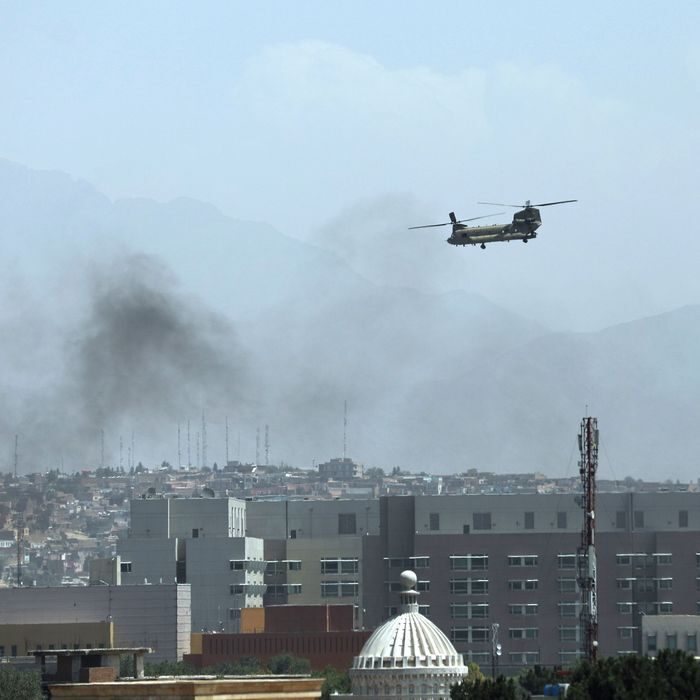
- U.S. Embassy left behind biometrics on Afghans who helped U.S.
- Taliban used the information to contact the Afghans with spoof emails, telling them report to fake "safe houses," where they were executed
As the capital of Kabul descended into chaos, the CIA managed to destroy all sensitive materials at its compound at the Ariana hotel prior to departing.
Operatives reportedly deployed the "vulcan fire," option, a multi-stage thermocorrosive chemical destroyer, to obliterate anything that the U.S. did not want to fall into the enemy's hands.
However, important and sensitive material was left behind a short distance away at the U.S. embassy.
That included decades of biometrics information collected about Afghans who assisted the American effort: fingerprints, facial recognition data, and information on their social media.
The biometrics files were quickly collected by the Islamic extremist Taliban.
What did the Taliban do with it?
According to information, the Taliban sent spoof emails, pretending that the emails were generated by the U.S. State Department, instructing the Afghans to report to "safe houses."
When the Afghans arrived at the fake "safe houses," the Taliban executed them.
"It's criminal that [the State Dept.] did not destroy" the biometrics database and information prior to evacuating the U.S. embassy, says a source in Kabul, at the time.
It's unclear whether the alleged failure to destroy the material was due to the rushed exit, or other reasons.
The U.S. military's killing of Afghan children
Another point of contention surrounds the horrifically bad call on the part of the U.S. military to drone-strike a vehicle that turned out to contain only innocent civilians.
Ten Afghans were killed, including seven children. No Taliban or ISIS terrorists were among the dead, even though U.S. military officials initially implied the strike had hit the right targets.
Military officers recently testified to Congress that they knew within a short period of time that civilians had been killed, but they did not publicly admit it at the time.
To date, no U.S. officials have been held accountable for the deaths.
One U.S. source who was in Kabul, and was not part of the drone strike, says numerous American officials were remotely monitoring as the U.S. drones marked the car in question.
"Word was that the car was supposedly full of explosives," says a source. "If so, then why blow it up in a neighborhood around a bunch of kids?"
The source says they watched with surprise as military drones marked the vehicle and quickly moved to blow it up.
"Everyone knew immediately there were no explosives [inside] because there was no residual explosion. Only a gas tank," says a source.
Undeclared evacuation operation
Another problem raised is that sources say they were told President Biden refused to allow declaration of a noncombatant evacuation operation (NEO). Such a designation, widely expected by those on the ground as Afghanistan fell, would have triggered a specific military and special operations response with an adequate number of U.S. troops heading to Kabul to assist in evacuations.
For example, 10,000 NEO troops, including U.S. forces from Kuwait, could have descended quickly upon Kabul. Some would have parachuted into Bagram air field, if allowed, to secure it and use it for evacuations.
But President Biden reportedly did not want that number of U.S. troops to go to the country even to help safely get Americans and Afghan allies out.
By not declaring a NEO, the military was reportedly limited to working with what it had and was unable to mount the necessary, by-the-book response.
Left behind
Among those whose biometrics were left behind were Afghan Counterterrorism Pursuit Teams or CTPTs.
"[The U.S.] trained and used 30,000 of them and their families," says a source.
As for the regular Afghan National Army (ANA) that quickly folded when the Taliban moved in: "They hadn't been paid in a year," says a source.
Although U.S. taxpayers have generously funded the ANA soldiers over two decades, multiple sources say there is so much corruption among the Afghan leadership that the money often didn't make it to the fighting forces.
Besides that, a Taliban member would hold a U.S.-made weapon to the head of an Afghan helicopter pilot, for example, and say, "You work for us now, or you and your family will be killed."
Residual damage
In the wake of the scandal, operators in other countries that assist the U.S. are said to be worried and skeptical.
"The [CIA] Director came to Afghanistan for talks with two of the top ten Most Wanted Taliban that we tried to kill for the past 20 years," says one. "Other countries are asking, 'Why would we help you?'"
That includes Kurds asked to help the U.S. in Northern Iraq. "Are we going to be like Afghanistan?" one source says the Kurds are asking.
As a result, Iran and Russia are able to get a new foothold in places where they'd been kept at bay.
U.S. leadership
Also thrown into question, according to numerous sources, is confidence in U.S. leadership.
"Now I know how [the last generation] felt about Vietnam," says one source. "America has suffered Pearl Harbor, 9/11, the Saigon pullout and now, my generation, Afghanistan."
Chairman of the Joint Chiefs of Staff General Mark Milley recently told Congress that the Afghanistan withdrawal was "a logistical success but a strategic failure."



Comment: See also: